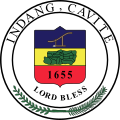Indang Indan | |
|---|---|
| Municipality of Indang | |
 Indang Municipal Hall | |
Nicknames:
| |
| Motto: Indang Atin 'to! [1] | |
 Map of Cavite with Indang highlighted | |
Location within the Philippines | |
| Coordinates: 14°12′N120°53′E / 14.2°N 120.88°E | |
| Country | Philippines |
| Region | Calabarzon |
| Province | Cavite |
| District | 7th district |
| Founded | 1655 |
| Barangays | 36 (see Barangays) |
| Government | |
| • Type | Sangguniang Bayan |
| • Mayor | Virgilio F. Fidel |
| • Vice Mayor | Ferdinand T. Papa |
| • Representative | Crispin Diego D. Remulla |
| • Municipal Council | Members |
| • Electorate | 46,671 voters (2025) |
| Area | |
• Total | 74.90 km2 (28.92 sq mi) |
| Elevation | 325 m (1,066 ft) |
| Highest elevation | 700 m (2,300 ft) |
| Lowest elevation | 49 m (161 ft) |
| Population (2024 census) [4] | |
• Total | 70,092 |
| • Density | 935.8/km2 (2,424/sq mi) |
| • Households | 17,012 |
| Demonym(s) | Indangeño, Taga-Indang |
| Economy | |
| • Income class | 1st municipal income class |
| • Poverty incidence | 10.24 |
| • Revenue | ₱ 342.8 million (2022) |
| • Assets | ₱ 606.3 million (2022) |
| • Expenditure | ₱ 250.4 million (2022) |
| • Liabilities | ₱ 188.6 million (2022) |
| Service provider | |
| • Electricity | Manila Electric Company (Meralco) |
| Time zone | UTC+8 (PST) |
| ZIP code | 4122 |
| PSGC | |
| IDD : area code | +63 (0)46 |
| Native languages | Tagalog |
| Major religions | |
| Feast date | September 3 |
| Catholic diocese | Diocese of Imus |
| Patron saint | Saint Gregory the Great |
| Website | www |
Indang, officially the Municipality of Indang (Tagalog : Bayan ng Indang), is a municipality in the province of Cavite, Philippines. According to the 2020 census, it has a population of 68,699 people. [6]
Contents
- Etymology
- History
- Before 1655: Separation and Independence
- 1896-1897: The Philippine Revolution
- 1906-1998: Cavite State University
- 1942-1945: Japanese occupation during World War II
- 1945: Post-war era
- 2008–2021: Tagaytay water crisis
- Geography
- Topography
- Elevation
- Climate
- Barangays
- Demographics
- Population
- Languages
- Religion
- Economy
- Agriculture
- Infrastructure
- Transportation
- Utilities
- Government
- Elected officials
- Education
- Primary and elementary schools
- Secondary schools
- Higher educational institution
- Notable people
- Sister city
- See also
- References
- External links














